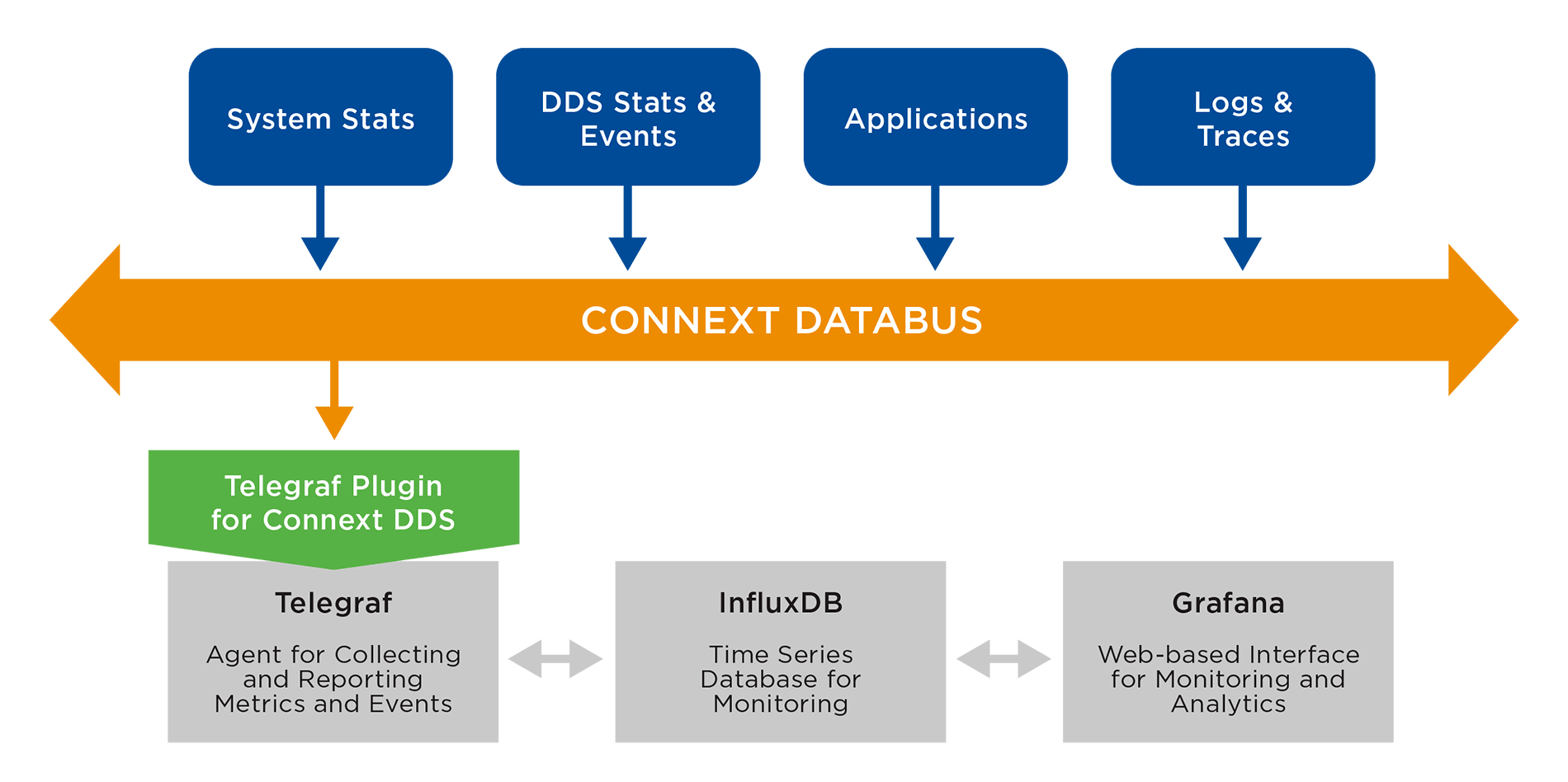Telegraf Plugin for Connext
A DDS plugin to Telegraf that subscribes to metrics, events, and logs in your DDS system and stores them in InfluxDB for visualization and alerts.

What does it do?
Telegraf is the minimal memory footprint monitoring agent written in the Go programming language for collecting, processing, aggregating and writing metrics. The Telegraf Plugin for Connext collects time-series metrics over Connext for monitoring and analysis. Developers use it to quickly extract and assimilate real-time metrics, events and logs from Connext into lightweight dashboards for analysis and action.
Telegraf provides more than 200 plugins in order for monitoring metrics to be collected from various sources and passed to various destinations. It also provides plugins for processing and aggregating metrics. With Telegraf Plugin for Connext, any DDS types and topics defined in XML can be subscribed, and they can flow into output plugins (e.g. InfluxDB). Collected DDS metrics can be easily processed, aggregated, and ingested for real-time monitoring and analysis through existing plugins supported by Telegraf.

Features & Benefits
- Subscribe to any DDS data
- Process and aggregate metrics
- Ingest to several output plugins
Subscribe to any DDS data: Any DDS topics and types can be defined in XML and converted to a format supported by Telegraf. Data distributed over DDS can be seamlessly consolidated in a monitoring system built with Telegraf.
Process and aggregate metrics: Subscribed DDS metrics can be easily processed, and aggregated with plugins supported by Telegraf for improved analysis and action.
Ingest to several output plugins: DDS metrics can be sent to several output plugins supported by Telegraf, such as InfluxDB, Graphite, Prometheus and Elasticsearch. This will enable easy integrations of the DDS databus with databases supported by Telegraf.All versions of Telegraf Plugin for Connext are available for download here: https://github.com/rticommunity/telegraf
RTI Labs Project Type: Plugin Extension for InfluxData’s Telegraf
Maturity Level: Prototype
Support. Telegraf Plugin for Connext is an experimental RTI prototype. As such, we only offer support through the RTI Community Forum where fellow users and RTI engineers can help you. If you encounter an issue while using Telegraf Plugin for Connext, you can also open a ticket in the issues section of the repository. We encourage you to post your feedback and questions on the Community Forum.
Intent. Telegraf Plugin for Connext is slated for continued development.
Feedback. Feedback should be submitted to RTI via the RTI Community Forum.
Platform Availability. The plugin software is Go-based and a direct plugin to Telegraf. Telegraf Plugin for Connext utilizes RTI Connector for the Go programming language. Please check platform support here.
Telegraf System Requirements. Telegraf requires Golang version 1.9 or newer.
Product Compatibility. RTI Connext version 5.3.0.
Telegraf is an agent written in Go for collecting, processing, aggregating, and writing metrics.
Its design goals are to have a minimal memory footprint with a plugin system so that developers in the community can easily add support for collecting metrics. For an example configuration referenced from local or remote services.
Telegraf is plugin-driven and has the concept of 4 distinct plugins:
- Input Plugins collect metrics from the system, services, or 3rd party APIs
- Processor Plugins transform, decorate, and/or filter metrics
- Aggregator Plugins create aggregate metrics (e.g. mean, min, max, quantiles, etc.)
- Output Plugins write metrics to various destinations
For more information on Processor and Aggregator plugins please read this.
It is a forked Telegraf repository adding a DDS input plugin (dds_consumer).
Telegraf Plugin for Connext documentation is located in the RTI Community GitHub repository.
Post your questions, search through our Knowledge Base and get the most from your DDS experience by joining the RTI Community.
 Success-Plan Services
Success-Plan Services